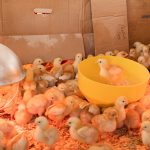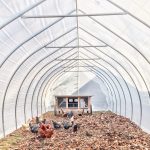Chickens have specific requirements for optimal health and well-being, particularly during winter. Proper shelter is essential to protect them from cold temperatures and harsh weather conditions. The coop should be well-insulated, draft-free, and provide adequate ventilation to prevent moisture buildup.
Nutrition is crucial during colder months. Chickens require a balanced diet with increased caloric intake to maintain body heat and energy levels. Providing high-quality feed, supplemented with scratch grains and occasional treats, can help meet their nutritional needs.
Access to fresh, unfrozen water is vital. Heated waterers or frequent water changes may be necessary in freezing temperatures. Adequate lighting is important for egg production and overall health.
Supplemental lighting may be required to maintain a consistent day length. Regular health checks are essential during winter. Monitor for signs of frostbite, respiratory issues, or other cold-related problems.
Ensure the flock has enough space to move and exercise to prevent boredom and maintain good circulation. By addressing these needs, chicken owners can help their flocks remain healthy, comfortable, and productive throughout the winter season.
Table of Contents
- 1 Providing Adequate Shelter for Chickens
- 2 Insulating the Chicken Coop
- 3 Using Heat Lamps or Heated Pads
- 4 Adjusting the Diet for Winter
- 5 Maintaining Clean Bedding
- 6 Monitoring the Health of Chickens
- 7 FAQs
- 7.1 What are the best ways to keep chickens warm in winter in Australia?
- 7.2 What should be the temperature inside the chicken coop during winter?
- 7.3 Are there specific breeds of chickens that are better suited for colder climates in Australia?
- 7.4 How can I provide additional warmth for my chickens without using electricity?
- 7.5 What are the risks of not keeping chickens warm during winter in Australia?
Key Takeaways
- Chickens need extra care in winter to stay healthy and comfortable
- Adequate shelter is essential to protect chickens from harsh weather conditions
- Insulating the chicken coop helps maintain a warm and dry environment
- Heat lamps or heated pads can be used to provide additional warmth
- Adjusting the diet with high-energy foods helps chickens stay warm and healthy
- Clean bedding is important for maintaining hygiene and warmth in the coop
- Regular monitoring of chicken health is crucial during the winter months
Providing Adequate Shelter for Chickens
Key Features of a Winter-Ready Coop
The coop should also be spacious enough to allow the chickens to move around comfortably and have access to nesting boxes for laying eggs.
Outdoor Space for Exercise and Safety
Additionally, it’s important to provide a secure outdoor area for the chickens to roam during the day, as long as it’s safe from predators and harsh weather conditions.
Coop Construction and Maintenance
When providing shelter for chickens in winter, it’s important to consider the materials used in the construction of the coop. Wood is a popular choice for its insulating properties, but it’s important to ensure that it’s well-sealed to prevent drafts. Additionally, adding extra bedding such as straw or wood shavings can provide additional insulation and warmth for the chickens. It’s also important to regularly clean the coop to prevent moisture buildup and the growth of harmful bacteria. By providing adequate shelter for your chickens, you can help them stay warm, dry, and comfortable throughout the winter months.
Insulating the Chicken Coop

Insulating the chicken coop is an important step in ensuring that your flock stays warm and comfortable during the winter months. Proper insulation can help regulate the temperature inside the coop, keeping it warmer in cold weather and cooler in hot weather. There are several ways to insulate a chicken coop, including adding insulation material to the walls, ceiling, and floor, as well as sealing any gaps or cracks that could let in drafts.
One effective way to insulate a chicken coop is by using foam board insulation, which can be cut to fit the walls and ceiling of the coop. Another option is to use reflective insulation, which can help retain heat in the winter and reflect it away in the summer. Additionally, adding weather stripping around doors and windows can help prevent drafts and keep the coop airtight.
It’s important to regularly check the insulation in the coop and make any necessary repairs or replacements to ensure that it continues to provide adequate protection from the elements.
Using Heat Lamps or Heated Pads
In some cases, especially in extremely cold climates, using heat lamps or heated pads may be necessary to provide additional warmth for chickens during the winter. Heat lamps can be hung in the coop to provide a source of warmth, while heated pads can be placed on the floor to create a cozy spot for the chickens to rest. It’s important to use these heating devices with caution, as they can pose a fire hazard if not properly installed and monitored.
When using heat lamps or heated pads, it’s important to place them in a safe location where they won’t come into contact with flammable materials or pose a risk of injury to the chickens. It’s also important to regularly check the devices for any signs of wear or damage and replace them as needed. Additionally, it’s important to monitor the temperature inside the coop and adjust the heating devices accordingly to ensure that the chickens are comfortable without overheating.
By using heat lamps or heated pads responsibly, you can provide additional warmth for your chickens during the winter months.
Adjusting the Diet for Winter
Adjusting the diet of your chickens for winter is an important step in ensuring that they get the nutrients and energy they need to stay healthy and warm. During the winter months, chickens may require additional calories to maintain their body heat and energy levels. This can be achieved by providing them with a higher protein feed or supplementing their diet with grains such as corn or oats.
In addition to adjusting their diet for increased energy needs, it’s important to ensure that your chickens have access to fresh water at all times. In cold weather, water can freeze quickly, so it’s important to regularly check and replace frozen water with fresh water to prevent dehydration. Additionally, providing warm water or adding electrolytes to their water can help keep your chickens hydrated and healthy during the winter months.
By adjusting their diet and ensuring they have access to fresh water, you can help your chickens stay nourished and hydrated throughout the winter.
Maintaining Clean Bedding

Regular Cleaning is Key
Regular cleaning of soiled bedding is essential, and it should be replaced with fresh material such as straw or wood shavings. This helps to maintain a clean and dry environment, which is essential for your chickens’ health and well-being.
Monitoring for Issues
In addition to regular cleaning, it’s essential to regularly inspect the bedding for signs of mold, mildew, or pests such as mites or lice. If any issues are found, it’s crucial to address them promptly to prevent them from spreading and causing harm to your chickens.
A Healthy Environment
By maintaining clean bedding in the coop, you can provide a comfortable and healthy environment for your flock throughout the winter months. This helps to reduce stress, prevent diseases, and keep your chickens happy and thriving.
Monitoring the Health of Chickens
Monitoring the health of your chickens is crucial during the winter months when they may be more susceptible to illness and stress. It’s important to regularly check on your flock for any signs of illness or injury, such as lethargy, loss of appetite, abnormal droppings, or respiratory issues. Additionally, it’s important to monitor their behavior and interactions with each other to ensure that they are getting along and not showing signs of aggression or stress.
In addition to regular visual checks, it’s important to handle your chickens regularly to check for any abnormalities such as lumps or injuries. It’s also important to keep an eye on their food and water intake and make adjustments as needed to ensure they are getting what they need. By monitoring the health of your chickens closely, you can catch any issues early and take appropriate action to keep them healthy throughout the winter months.
In conclusion, understanding and meeting the needs of chickens in winter is essential for ensuring their health and well-being. Providing adequate shelter, insulating the coop, using heating devices responsibly, adjusting their diet, maintaining clean bedding, and monitoring their health are all important steps in caring for your flock during the winter months. By taking these measures, you can help your chickens stay warm, comfortable, and healthy throughout the colder season.
If you’re looking for more tips on keeping poultry warm in the winter, you might want to check out this article on how to keep your chicken coop and nest box warm. It offers valuable advice on creating a cozy environment for your chickens during the colder months.
FAQs
What are the best ways to keep chickens warm in winter in Australia?
In Australia, the best ways to keep chickens warm in winter include providing a well-insulated coop, using heat lamps or heating pads, and ensuring proper ventilation to prevent moisture buildup.
What should be the temperature inside the chicken coop during winter?
The temperature inside the chicken coop during winter should ideally be kept above freezing, around 10-15 degrees Celsius, to ensure the chickens stay warm and healthy.
Are there specific breeds of chickens that are better suited for colder climates in Australia?
Yes, some chicken breeds such as Australorp, Orpington, and Wyandotte are better suited for colder climates in Australia due to their thicker feathers and cold-hardy nature.
How can I provide additional warmth for my chickens without using electricity?
You can provide additional warmth for your chickens without using electricity by using insulating materials such as straw or hay, providing extra bedding, and ensuring the coop is draft-free.
What are the risks of not keeping chickens warm during winter in Australia?
Not keeping chickens warm during winter in Australia can lead to health issues such as frostbite, respiratory problems, and decreased egg production. It can also increase the risk of mortality among the chickens.
Meet Walter, the feathered-friend fanatic of Florida! Nestled in the sunshine state, Walter struts through life with his feathered companions, clucking his way to happiness. With a coop that’s fancier than a five-star hotel, he’s the Don Juan of the chicken world. When he’s not teaching his hens to do the cha-cha, you’ll find him in a heated debate with his prized rooster, Sir Clucks-a-Lot. Walter’s poultry passion is no yolk; he’s the sunny-side-up guy you never knew you needed in your flock of friends!







